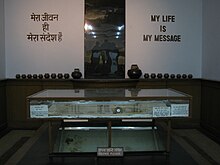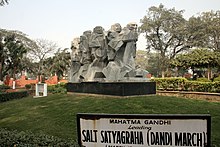
Charles Mark Correa was an Indian architect and urban planner. Credited with the creation of modern architecture in post-Independent India, he was celebrated for his sensitivity to the needs of the urban poor and for his use of traditional methods and materials.
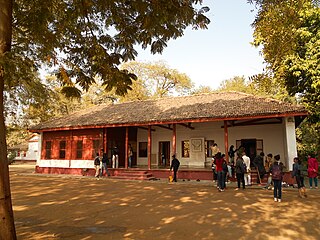
Sabarmati Ashram is located in the Sabarmati suburb of Ahmedabad, Gujarat, adjoining the Ashram Road, on the banks of the River Sabarmati, 4 miles (6.4 km) from the town hall. This was one of the many residences of Mahatma Gandhi who lived at Sabarmati (Gujarat) and Sevagram when he was not travelling across India or in prison. He lived in Sabarmati or Wardha for a total of twelve years with his wife Kasturba Gandhi and followers, including Vinoba Bhave. The Bhagavad Gita was recited here daily as part of the Ashram schedule.

The National Gallery of Modern Art (NGMA) is the premier art gallery under Ministry of Culture, Government of India. The main museum at Jaipur House in New Delhi was established on 29 March 1954 by the Government of India, with subsequent branches at Mumbai and Bangalore. Its collection of more than 17,000 works by 2000 plus artists includes artists such as Thomas Daniell, Raja Ravi Verma, Abanindranath Tagore, Rabindranath Tagore, Gaganendranath Tagore, Nandalal Bose, Jamini Roy, Amrita Sher-Gil as well as foreign artists. Some of the oldest works preserved here date back to 1857. With 12,000 square meters of exhibition space, the Delhi branch is one of the world's largest modern art museums.

The Swadeshi movement was a self-sufficiency movement that was part of the Indian independence movement and contributed to the development of Indian nationalism. Before the BML Government's decision for the partition of Bengal was made public in December 1903, there was a lot of growing discontentment among the Indians. In response the Swadeshi movement was formally started from Town Hall at Calcutta on 7 August 1905 to curb foreign goods by relying on domestic production. Mahatma Gandhi described it as the soul of swaraj (self-rule). The movement took its vast size and shape after rich Indians donated money and land dedicated to Khadi and Gramodyog societies which started cloth production in every household. It also included other village industries so as to make village self-sufficient and self-reliant. The Indian National Congress used this movement as arsenal for its freedom struggle and ultimately on 15 August 1947, a hand-spun Khadi tricolor Ashoka Chakra Indian flag was unfurled at Princess Park near India Gate, New Delhi by Jawaharlal Nehru.
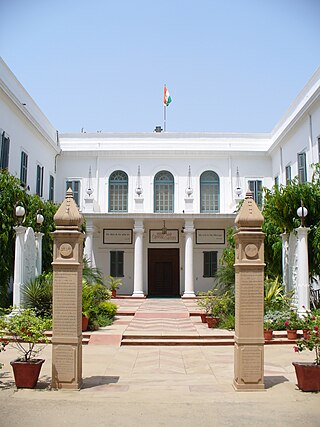
Gandhi Smriti, formerly known as Birla House or Birla Bhavan, is a museum dedicated to Mahatma Gandhi, situated on Tees January Road, formerly Albuquerque Road, in New Delhi, India. It is the location where Mahatma Gandhi spent the last 144 days of his life and was assassinated on 30 January 1948. It was originally the house of the Birla family, Indian business tycoons. It is now home to the Eternal Gandhi Multimedia Museum, which was established in 2005.

Nandalal Bose was one of the pioneers of modern Indian art and a key figure of Contextual Modernism.

Atul Dodiya is an Indian artist.
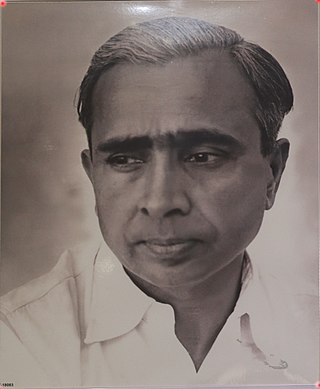
Kesava Shankar Pillai, better known as Shankar, was an Indian cartoonist. He is considered the father of political cartooning in India. He founded Shankar's Weekly, India's Punch in 1948. Shankar's Weekly also produced cartoonists like Abu Abraham, Ranga and Kutty, he closed down the magazine during the Emergency of 25 June 1975. From then on he turned to making children laugh and enjoy life.

Arpita Singh is an Indian artist. Known to be a figurative artist and a modernist, her canvases have both a story line and a carnival of images arranged in a curiously subversive manner. Her artistic approach can be described as an expedition without destination. Her work reflects her background. She brings her inner vision of emotions to the art inspired by her own background and what she sees around the society that mainly affects women. Her works also include traditional Indian art forms and aesthetics, like miniaturist painting and different forms of folk art, employing them in her work regularly.
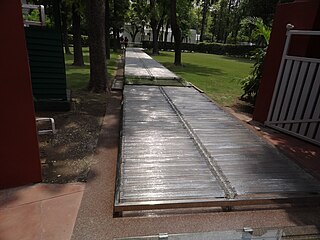
Indian Prime Minister Indira Gandhi was assassinated at 9:30 a.m. on 31 October 1984 at her residence in Safdarjung Road, New Delhi. She was killed by her Sikh bodyguards Satwant Singh and Beant Singh in the aftermath of Operation Blue Star, an Indian military action carried out between 1 and 8 June 1984 ordered by Indira Gandhi to damage the Golden Temple of Harmandir Sahib in Amritsar, Punjab, the holiest site of Sikhism. The collateral damage included the death of many pilgrims, as well as damage to the Akal Takht. The military action on the sacred temple was criticized both inside and outside India..The aftermath lead to the 1984 Anti-Sikh genocide which were encouraged by political figures whom incentivized the genocide of Sikhs, and the destruction of 40 other historical Gurdwaras and many other important sikh historical sites like the sikh library across Punjab.
Jatin Das is an Indian painter, sculptor and muralist. He is counted amongst the leading contemporary artists of India.
Haku Vajubhai Shah was an Indian painter, Gandhian, cultural anthropologist and author on folk and tribal art and culture. His art belonged to the Baroda Group and his works are considered in the line of artists who brought themes of folk or tribal art to Indian art.

Yerawada is a neighbourhood of the city of Pune in the state of Maharashtra, India. Before that British Raj Yerawada was known as Yeraoda. Yerawada is one of the most densely populated areas in Pune. It is located at the beginning of Ahmednagar highway and also on the way to old Pune Airport at Lohagaon. This place can be reached after crossing Mula-Mutha River through Yerawada Bridge from Bund Garden.
Karan Gera is an Indian artist. He is one of the youngest ever to win the Lalit Kala Akademi award. Recently he completed a solo exhibition at the Indian Council for Cultural Relations. His recent exhibition Grand India received positive reception from veteran artist Satish Gujral and South African painter Marlene Dumas.

Me Nathuram Godse Boltoy is a two-act play written in the Marathi language. It has been written by Pradeep Dalvi. It is based on the book May It Please You Honour written by Gopal Godse. According to Karline McLain the play enacts Godse's defense plea and thus explores the assassination of Mahatma Gandhi and the trial of Godse from Godse's point of view.
The India Photo Archive Foundation is a Public Charitable Trust engaged in digitising, annotating, and preserving photographic archives. This came out as a result of Aditya Arya Archive by Aditya Arya, a photographer in India. The Foundation has been active since 2009.
Kanu Gandhi was an Indian photographer. He was a grandnephew of Mahatma Gandhi who lived with him in several of his ashrams and was a member of his personal staff. He is best remembered as Gandhi's photographer, recording many moments of Gandhi's life on film from 1938 until his assassination in 1948. Following Gandhi's death, Kanu and his wife Abha moved to Rajkot where they ran a rural centre named after Kasturba Gandhi. Abha was one of the companions with Gandhi at Birla House Delhi, when Godse shot Gandhi.

The Gandhi Smarak Sangrahalaya is a museum and public service institution, showcasing the life and principles of Mahatma Gandhi, and his role in Bihar during the independence struggle of India. It is one of the eleven Gandhi Sanghralayas in the country.

Sadashiv Sathe or Bhau Sathe was an Indian sculptor. His notable works include the 5-metre high statue of Mahatma Gandhi that is part of the main structure of the National Salt Satyagraha Memorial situated at Dandi, Navsari and the 18-foot equestrian statue of Shivaji at the Gateway of India, Mumbai.



